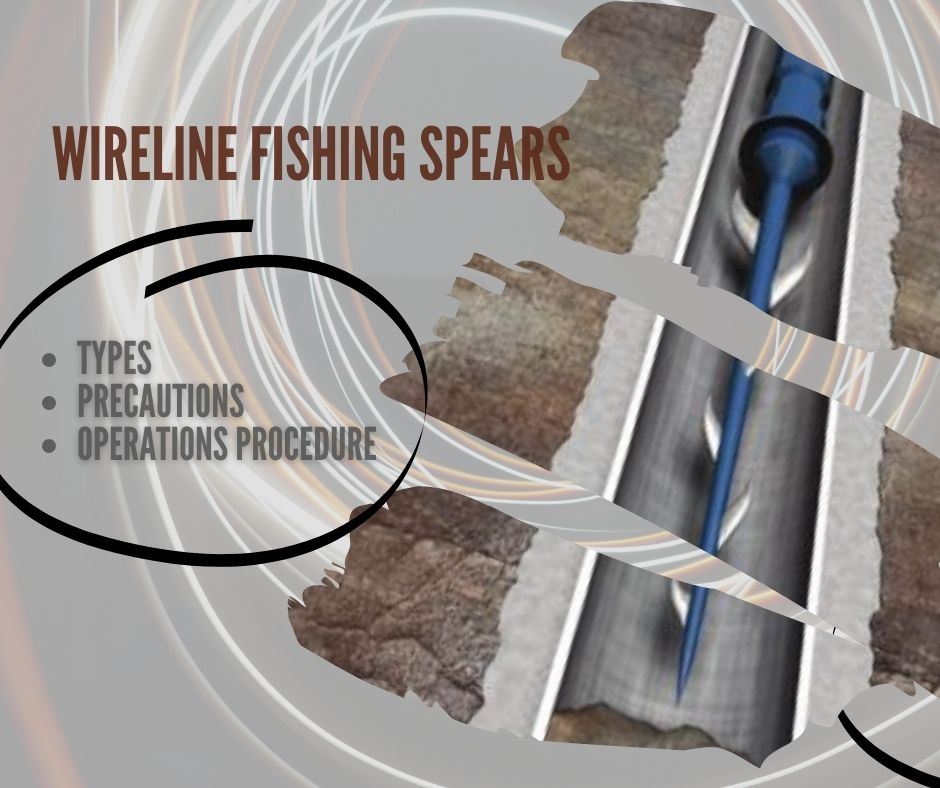
Wireline parted in the hole can be retrieved with either a center prong rope fishing spear, double prong spear, or crank type spear. A typical bottom hole assembly used to fish for wireline would consist of the following components:
- rope spear
- stop ring
- safety joint (optional)
- bumper sub
- oil jars
- drill collars
- accelerator jar (Mechanical Jar – Hydraulic Jar)
- fishing string.
In cased holes, always run a stop on top of the spear that is 1/8″ to ¼” less in OD than the drift ID of the casing. This is because if there is enough space, the line will get by the spear. A stop is never run in an open hole because of the possibility of the wire balling up above the spear, preventing re-entry of the spear into the casing.

center prong rope Wireline Fishing spear

A center prong rope spear is the most common tool used to fish parted wireline. It has a straight shaft with rounded barbs welded on the outside which face out and up. The center prong spear also has a top rotary connection to connect to a stop sub and related tools. The spear will usually not have an ID, therefore a drain sub is required.
These wireline spears can also be used to fish control lines or electric submersible pump cable left downhole in cased hole or open hole wells. In cased-hole applications, Baker Hughes Fishing Manual recommends that a stop always be run above the spear. In open-hole wells, BAker Hughes recommends not running a stop.
double prong spear
The double prong or jack-latch type spear is used when the lost wireline is believed to be balled up in the hole. The double prong spear has two shafts with sharpened barbs welded on the inside, facing each other. It is also fitted with a top rotary connection.
crankshaft spear

The crankshaft spear is used when the wireline is in a larger hole relative to the line size. This spear has a crooked shaft that is bent to cover the hole from side to side in a crankshaft fashion. It also has rounded barbs welded to the outside of the shaft and has a rotary box connection.
Precautions
Fishing for parted wireline with a spear is a dangerous operation and should only be performed by a fisherman experienced in this procedure. This is because the wireline can easily ball up so badly that it can cause the hole to be junked.
To avoid balling up the wireline, do not attempt to catch the wireline very far below the anticipated top of it. For example, if you caught the line with a spear and had 500 feet of line above the spear, as you pulled the pipe up, that 500 feet of the line would ball up on top of the spear, causing it to stick.
The biggest problem that you are faced with in this situation is to convince the company man not to catch the wireline with a lot of the line on top of the spear. Besides sticking the line, another problem is that the ball of wire will not enter the bottom of the casing. Because you cannot release a rope spear from the wireline, you’re in an impossible situation.
Engaging the fish with a spear
- Run the wireline fishing spear into the hole to the approximate depth of the wire line.
- When you reach the depth of the wire line, rotate the spear slightly (only a few rounds) to catch the wire.
Caution: Too much rotation may break the line into multiple parts.
- Pull out a full stand and look for any weight gain on the indicator. If there is the slightest gain, pull all the way out and check for a recovered fish.
Note: Do not be afraid to make dry runs (i.e., pulling out of the hole to check for a fish when no fish has actually been caught). It is better to have a few dry runs than to have to junk the hole.
- If no wire is recovered, go in the hole one stand deeper and try again.
- When the wireline is caught with the fishing spear and either the tool or the wireline is stuck, the wireline must be either pulled in two at some point, pulled into at the weak point, or you must pull the wireline and logging tool-free. If the logging tool is left in the hole, it can then be retrieved using conventional methods.
Note: If the wireline fishing job is taking a long time, it is a good idea to open the blowout preventer bonnets and remove any pieces of wireline that may fall back in the hole or interfere with the proper operation of the BOP Stacks.
Good explanation